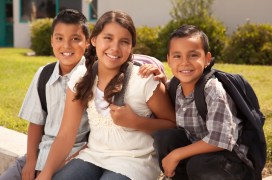
The recently released 2022 Census statistics reveal two converging facts about the U.S. population: It is aging, and, simultaneously, becoming increasing racially and ethnically diverse. Indeed, according to a Census news release: “Hispanic (of any race) is the largest gaining and second-fastest-growing race or Hispanic origin category, increasing by 767,907 or 1.24% from 2020 to 2021.” These newly released statistics line up with projections beyond 2030 that consistently point to the continual growth of a racially and ethnically pluralistic U.S. population, comprised of Latinx and other non-Hispanic white groups. Based on sheer population size and growth, Hispanic children and youth will shape the U.S. economic and political landscapes for years to come. Policy and legal decisions—ranging from federal legislative efforts such as the Build Back Better Act, the 2021 expanded child tax credit, and the overturning of federal protections such as those under Roe v. Wade—will inevitably have ripple effects on opportunities for Latino children and youth.
How this growing population of young people in the U.S. fares matters for a robust U.S. economy and society. Fortunately, we already know a lot about investing to marshal the strengths of Latino families and children.
Investing early and consistently toward college degree completion improves Latino labor market prospects and social integration
A considerable body of social science research shows that policy approaches, such as broad adoption of prenatal and early education programs within Hispanic communities, linguistically responsive curricula and teaching, and flexible hours that complement (rather than conflict with) parental employment generate long-term payoffs. Approaches such as dual-language programming and bilingual fluency of early care providers, co-location of early education programs in Hispanic-dense communities, and coordinated outreach between the child care subsidy system and Hispanic-serving organizations harness the strengths of Latino families and offset the disadvantages of low economic resources that many Latino children experience.
Investments in public infrastructure (the quality of public schools) and related public goods (e.g., parks and neighborhood safety) in concentrated areas of Latino families and children can reduce inequities in economic opportunity due to residential segregation. Family-school partnerships, addressing within-school and classroom racial/ethnic segregation and schoolwide and teacher discriminatory practices, and promotion of culturally and linguistically adaptive pedagogy can support Latino students’ math and reading achievement assessments that lag behind peers and are predictors of future earnings. The presence of Hispanic-serving institutions and in-state resident tuition benefits for immigrants have positive ripple effects in increasing Latino college degree completion that not only improve labor market prospects and economic security, but also contribute to social integration and intermarriage.
Investing in family social and economic support will enhance an already strong foundation of earnings, health, and parenting among Latino families with children
Latino parents exhibit high-quality nurturing interactions with their children despite many economic and social stressors. Multiple caregivers are involved in Latino children’s rearing. Public policy that moves beyond single-guardian and/or mother-centered targeting of investments can enhance this strong foundation of caregiver support to Latino children and youth and will facilitate better access to support. For example, vital information about family services, after school opportunities, health services, expanded nutrition programs, and tax credits could be communicated to parents and extended family members as a collective family benefit.
Latino children and youth are raised in homes with high rates of family employment, yet many Latino children and youth grow up in poverty. Earnings tend to be a stable source of income but at very low values. Policies that enhance earnings through tax credits or increasing minimum wages will not only increase overall household income but also improve financial stability in ways that support children’s home lives. Labor-market-oriented policies that improve the quality of parents’ physical and mental health (e.g., sick leave, safe work conditions, and predictable work schedules) also favorably spill over to the home environment and the quality of co-parenting.
Economic support provided through safety nets and related policies tend to be lower among income-eligible Latino families as compared to peers. Reducing administrative barriers and simplifying the navigation of publicly available services (e.g., documentation requirements, language translation, and literacy demands) can help with family and young people’s access to safety net programs. Anti-immigrant sentiment and local immigration enforcement actions have also had negative unintended consequences, referred to as “chilling effects,” for Latino children and youth (nearly all of whom are U.S. citizens). Programs, such as the Women, Infant, and Children’s program, that demonstrate higher uptake among Latino families offer useful lessons about ways to increase the receipt of cash supports (including emergency economic supports, such as those available during the pandemic) and that can undermine Latino family uptake of successful anti-poverty policies such as the Earned Income Tax Credit.
Escalated risks to Latino children and families from COVID-19 can be addressed through expanded social safety nets and capitalizing on social connectedness
Latino children and youth tend to reside in resilient families and communities but also have been exceptionally vulnerable to the COVID-19 pandemic. Hispanic children’s high risk of exposure to COVID-19 reflects both the segregation of their households in areas of overcrowded housing that became early COVID-19 “hot spots,” and their parents’ overrepresentation in “essential” jobs (e.g., health care, food preparation, and building maintenance). Poverty and social isolation due to the pandemic also increased adverse consequences to Latino youths’ physical and mental health. Hispanic children’s preexisting conditions, such as asthma, diabetes, and obesity, may have increased their risks of severe COVID-19. Recovery can be aided by the expansion of Medicaid and acceptance of telehealth provision of care, the simplification of social benefits administration (such as the creation of a general portal to receive pandemic stimulus checks that does not hinge on prior or current tax filings), and approaches that capitalize on the social connectedness of Latino communities and families.


